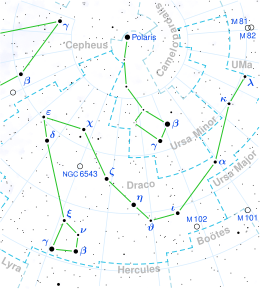
Back الثعبان (نجم) Arabic Thuban AST Thuban Catalan HD123299 CE Thuban Czech Thuban German Θουμπάν Greek Thuban Spanish ثعبان Persian Alpha Draconis French
| Observation data Epoch J2000 Equinox J2000 | |
|---|---|
| Constellation | Draco |
| Right ascension | 14h 04m 23.3500s[1] |
| Declination | 64° 22′ 33.062″[1] |
| Apparent magnitude (V) | 3.67[2] |
| Characteristics | |
| Spectral type | A0IV + A1V[3] |
| U−B color index | −0.08 |
| B−V color index | −0.049±0.005[2] |
| Variable type | suspected Maia[4] |
| Astrometry | |
| Radial velocity (Rv) | −13.0 km/s |
| Proper motion (μ) | RA: −56.34[1] mas/yr Dec.: 17.21[1] mas/yr |
| Parallax (π) | 10.76 ± 0.17 mas[1] |
| Distance | 303 ± 5 ly (93 ± 1 pc) |
| Absolute magnitude (MV) | −1.20[5] |
| Orbit[3] | |
| Period (P) | 51.417350 d |
| Semi-major axis (a) | 5.52 mas |
| Eccentricity (e) | 0.43 |
| Inclination (i) | 85.4° |
| Longitude of the node (Ω) | 252.6° |
| Periastron epoch (T) | JD 2453498.8 |
| Argument of periastron (ω) (secondary) | 22.4° |
| Semi-amplitude (K1) (primary) | 48.512 km/s |
| Semi-amplitude (K2) (secondary) | 63.58 km/s |
| Details[3] | |
| α Draconis A Alpha Draconis A | |
| Mass | 3.186 M☉ |
| Radius | 4.932 R☉ |
| Luminosity | 240 L☉ |
| Surface gravity (log g) | 3.555 cgs |
| Temperature | 10225 K |
| Rotational velocity (v sin i) | 25.4 km/s |
| Age | 280 Myr |
| α Draconis B Alpha Draconis B | |
| Mass | 2.431 M☉ |
| Radius | 2.326 R☉ |
| Luminosity | 47.5 L☉ |
| Surface gravity (log g) | 4.090 cgs |
| Temperature | 9930 K |
| Rotational velocity (v sin i) | 168 km/s |
| Age | 345 Myr |
| Other designations | |
| Database references | |
| SIMBAD | data |
Thuban (/ˈθjuːbæn/),[6] with Bayer designation Alpha Draconis or α Draconis, is a binary star system in the northern constellation of Draco. A relatively inconspicuous star in the night sky of the Northern Hemisphere, it is historically significant as having been the north pole star from the 4th to 2nd millennium BC.
Johann Bayer gave Thuban the designation Alpha and placed it as the only member of his secundae magnitude class in Draco, although its current apparent magnitude of 3.65 means it is 3.7 times fainter than the brightest star in the constellation, Gamma Draconis (Eltanin), which Bayer placed in his tertiae magnitude class although its current apparent magnitude is 2.24.[7]
- ^ a b c d e Van Leeuwen, F. (2007). "Validation of the new Hipparcos reduction". Astronomy and Astrophysics. 474 (2): 653–664. arXiv:0708.1752. Bibcode:2007A&A...474..653V. doi:10.1051/0004-6361:20078357. S2CID 18759600.
- ^ a b Anderson, E.; Francis, Ch. (2012), "XHIP: An extended hipparcos compilation", Astronomy Letters, 38 (5): 331, arXiv:1108.4971, Bibcode:2012AstL...38..331A, doi:10.1134/S1063773712050015, S2CID 119257644.
- ^ a b c Pavlovski, K.; Hummel, C. A.; Tkachenko, A.; Dervişoğlu, A.; Kayhan, C.; Zavala, R. T.; Hutter, D. J.; Tycner, C.; Şahin, T.; Audenaert, J.; Baeyens, R.; Bodensteiner, J.; Bowman, D. M.; Gebruers, S.; Jannsen, N. E.; Mombarg, J. S. G. (2022). "Dynamical parallax, physical parameters, and evolutionary status of the components of the bright eclipsing binary α Draconis". Astronomy & Astrophysics. 658: A92. arXiv:2111.03887. Bibcode:2022A&A...658A..92P. doi:10.1051/0004-6361/202142292. S2CID 243847585.
- ^ Kallinger, T.; Iliev, I.; Lehmann, H.; Weiss, W. W. (2005). "The puzzling Maia candidate star α Draconis". Proceedings of the International Astronomical Union. 2004: 848–852. Bibcode:2004IAUS..224..848K. doi:10.1017/S1743921305009865.
- ^ Murphy, Simon J.; Paunzen, Ernst (2017). "Gaia's view of the λ Boo star puzzle". Monthly Notices of the Royal Astronomical Society. 466 (1): 546. arXiv:1612.01528. Bibcode:2017MNRAS.466..546M. doi:10.1093/mnras/stw3141. S2CID 119328659.
- ^ Kunitzsch, Paul; Smart, Tim (2006). A Dictionary of Modern star Names: A Short Guide to 254 Star Names and Their Derivations (2nd rev. ed.). Cambridge, Massachusetts: Sky Pub. ISBN 978-1-931559-44-7.
- ^ Johann Bayer (1603). Uranometria: Omnivm Asterismorvm Continens Schemata, Nova Methodo Delineata, Aereis Laminis Expressa.
© MMXXIII Rich X Search. We shall prevail. All rights reserved. Rich X Search
